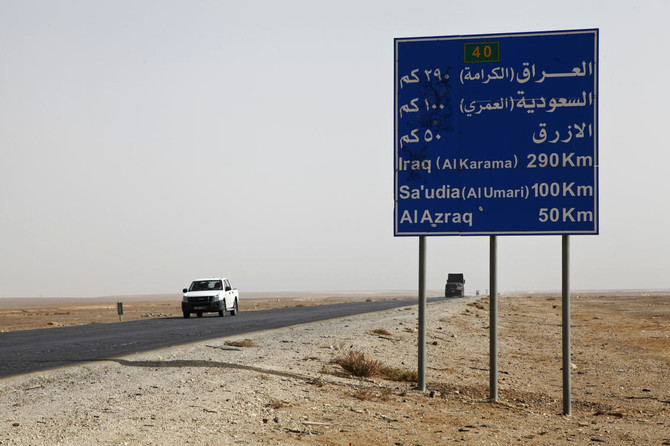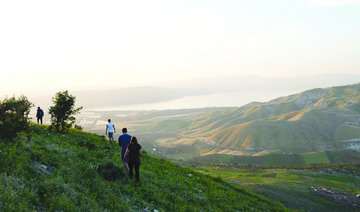MADOUNEH, Jordan: A shiny new city is to arise from Jordan’s desert over the next three decades, potentially rivaling the kingdom’s capital of Amman, a rapidly growing and increasingly unwieldy metropolis of 4 million people.
Announcing plans for what it portrays as a high-tech utopia, Jordan joined other Middle Eastern countries betting on multi-million-dollar mega projects as an investment magnet and quick economic fix.
Yet some urban planners warn that “cities from scratch” are risky endeavors and argue it’s more efficient to improve existing cities.
In Jordan, the government promises the yet-to-be-named city will draw population away from Amman, relieve its crippling traffic jams, provide middle-class housing and inject momentum into a sluggish economy plagued by high unemployment.
But authorities have released only snippets of information since the prime minister mentioned the new city for the first time, seemingly casually, in a meeting with local journalists in late October.
This perceived secrecy and “top-down” approach has drawn widespread criticism.
Few Jordanians have shown much enthusiasm, even among Amman residents who complain constantly of the city’s traffic. Some suspect the new city is largely meant to benefit Jordan’s powerful and their business cronies. Government officials deny that.
This week, Amman Mayor Yousef Shawarbeh defended the rocky rollout in a meeting with business people, diplomats and representatives of the energy and environmental sectors, many of whom seemed skeptical.
“The topic hasn’t been fully studied yet,” the mayor said when pressed for details. “When we conclude the studies, we will announce plans and have clear roles for government, citizens, investors, and so on.”
Shawarbeh insisted that Amman would not be neglected as Jordan, buckling under record public debt, shifts scarce resources to the new project. “The new city is not a new Amman,” he said. But it is needed, he argued, to relieve pressure on the capital.
Amman was a hamlet just a century ago and is seen as an upstart among the region’s ancient cities, such as Baghdad and Cairo. Today, Amman is home to more than 40 percent of Jordan’s population of 9.5 million.
Almost every hour of the day is rush hour and urban sprawl is rapidly devouring precious green areas. Districts of mid-rise, sand-covered residential buildings spread over hills and valleys, with a few high-rise towers marking the city center.
Rapid growth has been driven by an influx of hundreds of thousands of Palestinian, Syrian and Iraqi refugees in recent decades.
It is also linked to accelerated urbanization across the Middle East and North Africa, where populations flock from underdeveloped rural areas into cities looking for greater job opportunities. By 2050, more than two-thirds of the region’s anticipated 646 million people will live in cities, compared to 56 percent of 357 million people in 2010, according to UN projections.
In the past two decades, some two dozen new city projects were announced in the Middle East. About half remain “power point cities” existing only on websites, said Sarah Moser, an urban geography professor at McGill University in Montreal. Others are well behind schedule.
She said builders of new cities often underestimate challenges, including raising huge sums of capital and finding the necessary expertise. In such for-profit enterprises, plans for less lucrative public transport systems often remain on paper.
“I would suggest Jordan proceed with caution,” Moser said.
Egypt’s multi-billion-dollar plan for a new capital, announced in 2015, fell behind schedule after the country switched contractors. But President Abdel Fattah El-Sisi is determined to forge ahead. He plans to rule from the new city by 2019, leaving behind unruly Cairo, the Arab world’s largest city.
When pressed why the government is spending huge sums at a time of economic hardship, he said recently: “Isn’t it our right to have a dream? Is it wrong to have 13 cities like this or what? Don’t we deserve it?“
Several planned cities did advance over the years, including King Abdullah Economic City in Saudi Arabia, Modiin in Israel and Rawabi in the Palestinian territories.
Jordan’s new city would be built about 30 kilometers east of Amman on a desolate desert plain flanked by roads leading to Saudi Arabia, Iraq and — in the future — the country’s main airport. It’s to be built as a public-private partnership on state land, with first tenders to be submitted by mid-2018.
Officials have said little about how it will look other than describing it as a “smart city” running on renewable energy and boasting public transport. Eventually it would cover 390 square kilometers, an area a little smaller than the borough of Queens in New York City.
The first phase is to be completed by 2030 and the entire project by 2050, but the government has not announced a target population size. Many government departments and public institutions are to relocate there, it said. Housing cooperatives of civil servants, professionals and former members of the security forces would be able to build in the new city.
During a visit last week, the earmarked area was largely deserted, except for the occasional truck and car passing. The closest human activity is a truck station called Madouneh, though further out in the deserts beyond the site lie the Azraq camp for Syrian refugees, a military base and scattered abandoned ancient fortresses called qasrs.
The city is meant to ease overcrowding in Amman and Zarqa, a working-class city of 1.3 million. With urban sprawl, the two cities have been growing toward each other and are expected to have a combined population of 10 million by 2050.
Some suspect that the urban construction plans are largely meant to distract from economic problems, including tax hikes and further subsidy cuts, including for bread. “It makes people busy with a long-term vision” at a time of painful fiscal decisions, said political analyst Amer Sabaileh.
Critics also predict it will sap any development in Amman and Jordan’s other cities, chaotic and decidedly not high-tech and gleaming.
“Our cities should be developed, instead of building another one,” said Maram Tawil, an urban planning professor at the German-Jordanian University in Amman.
Tawil and colleagues at her university propose, among other things, to create service centers in urban neighborhoods to relieve traffic pressure on the city center and help save green spaces.
Tawil called on city planners to look for strategic solutions, saying that if Amman keeps growing at the current uncontrolled pace, “it will be impossible to live in.”
If it’s business as usual, then “a new Amman will be needed,” she said.
Jordan says planned city in the desert will not be ‘new Amman’
Jordan says planned city in the desert will not be ‘new Amman’

Gaza hospital says 20 killed in Israeli strike on Nuseirat

- Hospital statement: Israeli air strike targeted a house belonging to the Hassan family in Al-Nuseirat refugee camp in central Gaza
GAZA STRIP, Palestinian Territories: A Gaza hospital said Sunday that an Israeli air strike targeting a house at a refugee camp in the center of the Palestinian territory killed at least 20 people.
“We received 20 fatalities and several wounded after an Israeli air strike targeted a house belonging to the Hassan family in Al-Nuseirat refugee camp in central Gaza,” the Al-Aqsa Martyrs Hospital said in a statement.
Witnesses said the strike occurred around 3:00 a.m. local time. The Israeli army said it was checking the report.
Palestinian official news agency Wafa reported that the wounded included several children, and rescuers were searching for missing people trapped under the rubble.
Fierce battles and heavy Israeli bombardments have been reported in the central Nuseirat camp since the military launched a “targeted” operation focussing on the southern city of Rafah in early May.
Palestinian militants and Israeli troops have also clashed in north Gaza’s Jabalia camp for days now.
Witnesses said several other houses were targeted in air strikes during the night across Gaza, and that air strikes and artillery shelling also hit parts of Rafah during the night.
The Israeli military said two more soldiers were killed in Gaza the previous day.
The military said 282 soldiers have been killed so far in the Gaza military campaign since the start of the ground offensive on October 27.
Houthi missile strikes China-bound oil tanker in Red Sea

- The vessel and crew are safe and continuing to its next port of call: UKMTO
- The incident occurred 76 nautical miles (140 kilometers) off Yemen’s Hodeidah
AL-MUKALLA: Yemen’s Houthi militia launched an anti-ship ballistic missile into the Red Sea on Saturday morning, striking an oil tanker traveling from Russia to China, according to US Central Command, the latest in a series of Houthi maritime strikes.
CENTCOM said that at 1 a.m. on Saturday, a Houthi anti-ship ballistic missile struck a Panamanian-flagged, Greek-owned and operated oil tanker named M/T Wind, which had just visited Russia and was on its way to China, causing “flooding which resulted in the loss of propulsion and steering.”
Slamming the Houthis for attacking ships, the US military said: “The crew of M/T Wind was able to restore propulsion and steering, and no casualties were reported. M/T Wind resumed its course under its power. This continued malign and reckless behavior by the Iranian-backed Houthis threatens regional stability and endangers the lives of mariners across the Red Sea and Gulf of Aden.”
Earlier on Saturday, two UK naval agencies said that a ship sailing in the Red Sea suffered minor damage after being hit by an item thought to be a missile launched by Yemen’s Houthi militia from an area under their control.
The UK Maritime Trade Operations, which monitors ship attacks, said on Saturday morning that it received an alarm from a ship master about an “unknown object” striking the ship’s port quarter, 98 miles south of Hodeidah, inflicting minor damage.
“The vessel and crew are safe and continuing to its next port of call,” UKMTO said in its notice about the incident, encouraging ships in the Red Sea to exercise caution and report any incidents.
Hours earlier, the same UK maritime agency stated that the assault happened 76 nautical miles northwest of Hodeidah.
Ambrey, a UK security firm, also reported receiving information regarding a missile strike on a crude oil tanker traveling under the Panama flag, around 10 nautical miles southwest of Yemen’s government-controlled town of Mokha on the Red Sea, which resulted in a fire on the ship.
The Houthis did not claim responsibility for fresh ship strikes on Saturday, although they generally do so days after the attack.
Since November, the Houthis have seized a commercial ship, sunk another, and claimed to have fired hundreds of ballistic missiles at international commercial and naval ships in the Gulf of Aden, Bab Al-Mandab Strait, and Red Sea in what the Yemeni militia claims is support for the Palestinian people.
The Houthis claim that they solely strike Israel-linked ships and those traveling or transporting products to Israel in order to pressure the latter to cease its war in Gaza.
The US responded to the Houthi attacks by branding them as terrorists, forming a coalition of marine task forces to safeguard ships, and unleashing hundreds of strikes on Houthi sites in Yemen.
Local and international environmentalists have long warned that Houthi attacks on ships carrying fuel or other chemicals might lead to an environmental calamity near Yemen’s coast.
The early warning came in February when the Houthis launched a missile that seriously damaged the MV Rubymar, a Belize-flagged and Lebanese-operated ship carrying 22,000 tonnes of ammonium phosphate-sulfate NPS fertilizer and more than 200 tonnes of fuel while cruising in the Red Sea.
The Houthis have defied demands for de-escalation in the Red Sea and continue to organize massive rallies in regions under their control to express support for their campaign. On Friday, thousands of Houthi sympathizers took to the streets of Sanaa, Saada, and other cities under their control to show their support for the war on ships.
The Houthis shouted in unison, “We have no red line, and what’s coming is far worse,” as they raised the Palestinian and militia flags in Al-Sabeen Square on Friday, repeating their leader’s promise to intensify assaults on ships.
Meanwhile, a Yemeni government soldier was killed and another was injured on Saturday while fending off a Houthi attack on their position near the border between the provinces of Taiz and Lahj.
According to local media, the Houthis attacked the government’s Nation’s Shield Forces in the contested Hayfan district of Taiz province, attempting to capture control of additional territory.
The Houthis were forced to stop their attack after encountering tough resistance from government troops.
The attack occurred a day after the Nation’s Shield Forces sent dozens of armed vehicles and personnel to the same locations to boost their forces and repel Houthi attacks.
Israel war cabinet minister says to quit unless Gaza plan approved

- The Israeli army has been battling Hamas militants across the Gaza Strip for more than seven months
JERUSALEM: Israeli war cabinet minister Benny Gantz said Saturday he would resign from the body unless Prime Minister Benjamin Netanyahu approved a post-war plan for the Gaza Strip.
“The war cabinet must formulate and approve by June 8 an action plan that will lead to the realization of six strategic goals of national importance.. (or) we will be forced to resign from the government,” Gantz said, referring to his party, in a televised address directed at Netanyahu.
Gantz said the six goals included toppling Hamas, ensuring Israeli security control over the Palestinian territory and returning Israeli hostages.
“Along with maintaining Israeli security control, establish an American, European, Arab and Palestinian administration that will manage civilian affairs in the Gaza Strip and lay the foundation for a future alternative that is not Hamas or (Mahmud) Abbas,” he said, referring to the president of the Palestinian Authority.
He also urged the normalization of ties with Saudi Arabia “as part of an overall move that will create an alliance with the free world and the Arab world against Iran and its affiliates.”
Netanyahu responded to Gantz’s threat on Saturday by slamming the minister’s demands as “washed-up words whose meaning is clear: the end of the war and a defeat for Israel, the abandoning of most of the hostages, leaving Hamas intact and the establishment of a Palestinian state.”
The Israeli army has been battling Hamas militants across the Gaza Strip for more than seven months.
But broad splits have emerged in the Israeli war cabinet in recent days after Hamas fighters regrouped in northern Gaza, an area where Israel previously said the group had been neutralized.
Netanyahu came under personal attack from Defense Minister Yoav Gallant on Wednesday for failing to rule out an Israeli government in Gaza after the war.
The Gaza war broke out after Hamas’s attack on October 7 on southern Israel which resulted in the deaths of more than 1,170 people, mostly civilians, according to an AFP tally of Israeli official figures.
The militants also seized about 250 hostages, 124 of whom Israel estimates remain in Gaza, including 37 the military says are dead.
Israel’s military retaliation against Hamas has killed at least 35,386 people, mostly civilians, according to the Hamas-run Gaza’s health ministry, and an Israeli siege has brought dire food shortages and the threat of famine.
Iran to send experts to ally Venezuela to help with medical accelerators

- “Venezuela has a number of accelerators in its hospitals that have been stopped due to the embargo,” the message said
CARACAS: Iran on Saturday said it will send experts to its ally Venezuela to help with medical accelerators in hospitals it said had been stopped due to Western sanctions.
Venezuela requested Iran’s help, according to a message on the social media platform X by the Iranian government attributed to the head of the Atomic Energy Organization of Iran.
“Venezuela has a number of accelerators in its hospitals that have been stopped due to the embargo,” the message said.
Medical accelerators are used in radiation treatments for cancer patients.
Venezuela is also an ally of Russia and China.
The return of US sanctions on Venezuela’s oil industry has made its alliance with Iran critical to keeping its lagging energy sector afloat. Washington last year temporarily relaxed sanctions on Venezuela’s promise to allow a competitive presidential election. The US now says only some conditions were met.
Three Syrians missing after cargo ship sinks off Romania

- Eight sailors were rescued by one of the nearby commercial vessels, while the search for the other three, “all of Syrian nationality,” was continuing, the statement said
BUCHAREST: Romanian rescue teams on Saturday were scouring the Black Sea for three Syrian sailors who went missing when their cargo ship sank off the coast, the naval authority said.
The Mohammed Z sank with 11 crew on board, 26 nautical miles off the Romanian town of Sfantu Gheorghe in the Danube delta in the Black Sea on Saturday morning, officials said in a statement.
The ship sailing under the Tanzanian flag was carrying nine Syrian and two Egyptian nationals, it said.
After receiving an alert at “around 4:00am,” naval authorities and border police were dispatched, with two nearby commercial vessels also joining the search and rescue operation.
Eight sailors were rescued by one of the nearby commercial vessels, while the search for the other three, “all of Syrian nationality,” was continuing, the statement said.
The cause of the accident was unclear.
According to the specialist website Marine Traffic, the ship departed from the Turkish port of Mersin and was heading to the Romanian port of Sulina.
Since the start of Russia’s war in Ukraine, drifting sea mines have posed a constant threat for ships in the Black Sea, with countries bordering it doubling down on demining efforts.
Ensuring safe passage through the Black Sea has gained particular importance since Romania’s Danube ports became hubs for the transit of grain following the Russian blockade of Ukraine’s ports.



















